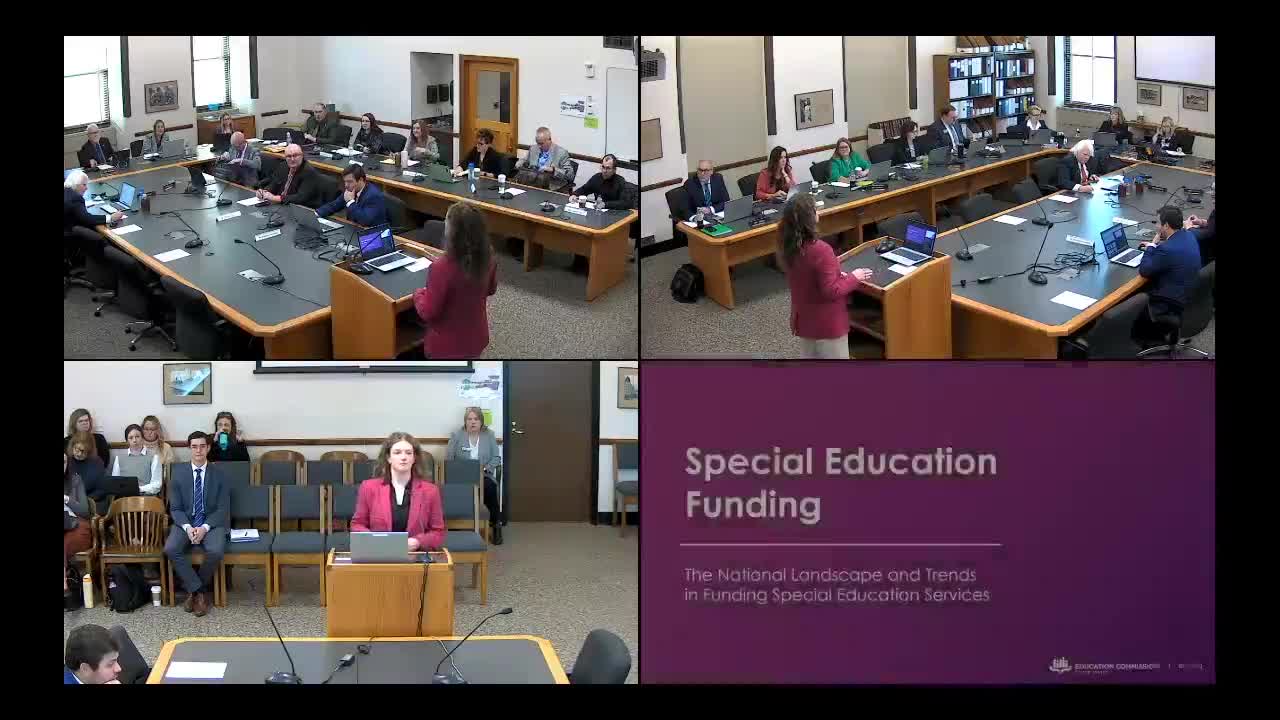States vary widely on special‑education funding; national nonprofit presents five approaches
November 05, 2025 | Legislative, North Dakota

This article was created by AI summarizing key points discussed. AI makes mistakes, so for full details and context, please refer to the video of the full meeting. Please report any errors so we can fix them. Report an error »

The Education Commission of the States (ECS) told the Special Education Funding Committee that there is no single national model for funding special education and laid out five commonly used approaches.
ECS North Dakota liaison Madeline Creek and presenter Chris Duncombe told the committee that states are under pressure as identification rates and the use of individualized education programs (IEPs) have increased nationwide. "We're a nonpartisan, nonprofit education policy research organization," Creek said in opening remarks. Duncombe said, "utilization of special education services. It's been the big cost driver nationally." The presenters said North Dakota's identification rate has roughly tracked national trends.
Why it matters: Different funding designs change incentives and the ability of districts to serve high‑need students. Weighted funding adds a percentage or dollar amount for students with IEPs; census models allocate additional dollars per total enrollment; reimbursement pays districts back for eligible costs; resource allocation uses staffing targets and funds positions; and high‑cost supplements reimburse extraordinary out‑of‑district placements. ECS cautioned that no single approach guarantees better educational outcomes.
Key details: ECS listed five models and examples: several states use single or multiple weights (Ohio was cited for multiple weights), 13 states use census approaches (North Dakota among them), some states reimburse districts for special‑education costs (Wyoming reimburses 100% of allowable costs), resource allocation models tie funds to staff ratios and evidence‑based targets (Illinois), and 23 states supplement very high‑cost placements through an excess‑cost program. Duncombe noted that many states use combinations of these approaches rather than 1 single model.
Committee questioning focused on three priorities: how to separate students by level of need, whether higher funding leads to better outcomes, and how to limit incentives to over‑identify students. Representative Murphy asked for clearer demographic splits between students with severe cognitive disabilities and those who are behind academically; Duncombe said that states differ in the detail they track and that some states distinguish by placement or service intensity.
What ECS recommended: Consider differentiating funding to match student need, maintain or expand high‑cost reimbursement for out‑of‑district placements, use regional service providers for low‑incident disabilities, and invest in recruitment and retention for special‑education personnel.
Committee action: No vote was taken on policy; members asked staff for follow‑up materials comparing state models and for examples of regional service units and recruitment programs.
Sources: Remarks and slides from Madeline Creek and Chris Duncombe of the Education Commission of the States, committee Q&A (transcript).
ECS North Dakota liaison Madeline Creek and presenter Chris Duncombe told the committee that states are under pressure as identification rates and the use of individualized education programs (IEPs) have increased nationwide. "We're a nonpartisan, nonprofit education policy research organization," Creek said in opening remarks. Duncombe said, "utilization of special education services. It's been the big cost driver nationally." The presenters said North Dakota's identification rate has roughly tracked national trends.
Why it matters: Different funding designs change incentives and the ability of districts to serve high‑need students. Weighted funding adds a percentage or dollar amount for students with IEPs; census models allocate additional dollars per total enrollment; reimbursement pays districts back for eligible costs; resource allocation uses staffing targets and funds positions; and high‑cost supplements reimburse extraordinary out‑of‑district placements. ECS cautioned that no single approach guarantees better educational outcomes.
Key details: ECS listed five models and examples: several states use single or multiple weights (Ohio was cited for multiple weights), 13 states use census approaches (North Dakota among them), some states reimburse districts for special‑education costs (Wyoming reimburses 100% of allowable costs), resource allocation models tie funds to staff ratios and evidence‑based targets (Illinois), and 23 states supplement very high‑cost placements through an excess‑cost program. Duncombe noted that many states use combinations of these approaches rather than 1 single model.
Committee questioning focused on three priorities: how to separate students by level of need, whether higher funding leads to better outcomes, and how to limit incentives to over‑identify students. Representative Murphy asked for clearer demographic splits between students with severe cognitive disabilities and those who are behind academically; Duncombe said that states differ in the detail they track and that some states distinguish by placement or service intensity.
What ECS recommended: Consider differentiating funding to match student need, maintain or expand high‑cost reimbursement for out‑of‑district placements, use regional service providers for low‑incident disabilities, and invest in recruitment and retention for special‑education personnel.
Committee action: No vote was taken on policy; members asked staff for follow‑up materials comparing state models and for examples of regional service units and recruitment programs.
Sources: Remarks and slides from Madeline Creek and Chris Duncombe of the Education Commission of the States, committee Q&A (transcript).
View full meeting
This article is based on a recent meeting—watch the full video and explore the complete transcript for deeper insights into the discussion.
View full meeting
